
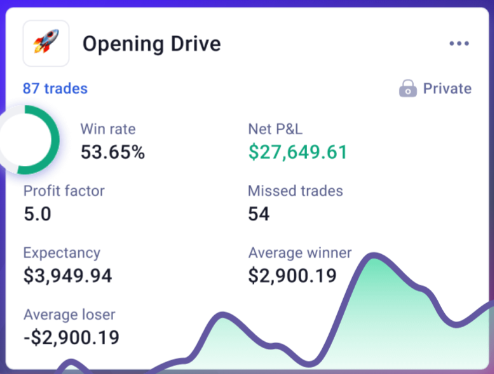
- Multi-Timeframe Backtesting
- Replay Price Action by the Second
- Up to 10 Years of Historical Data
- Advanced Risk Management
- Seamless Trade Journaling
- Economic Calendar Integration
- Custom Templates for Strategy Testing
If you’ve ever wanted to test your trading strategies risk-free, then TradeZella’s backtesting tool might be exactly what you need.
With TradeZella, you can go back in time, select any instrument (Forex, stocks, crypto, futures, etc.), and place trades as if it were a live market.
The tool lets you tweak your risk settings, test different order types, and analyze detailed stats—all without risking real money.
But is it worth it? And how does it compare to alternatives?
We tested TradeZella’s backtesting feature, and here’s what we found.
What is TradeZella’s Backtesting Feature?
TradeZella’s backtesting feature lets traders simulate past market conditions and test their strategies without live market risk.
Here’s how it works:
- Pick an instrument (Forex, stocks, crypto, futures.)
- Choose a historical time period
- Place trades as if it were live
- Adjust position sizes, stop losses, and risk settings
- Track detailed performance analytics
This is one of the best ways to improve your trading—you can spot weaknesses in your strategies and refine them before trading real money.
How We Tested It:
We set up a $100,000 virtual balance and tested TradeZella’s backtesting tool on US30 for a 1-month period.
We simulated trades, tracked P&L, and analyzed the effectiveness of different strategies.
Here’s what we found:
Getting Started with TradeZella Backtesting:
Let’s begin.
Step 1: Creating a Backtesting Session
To get started, click on Backtesting in the left panel:
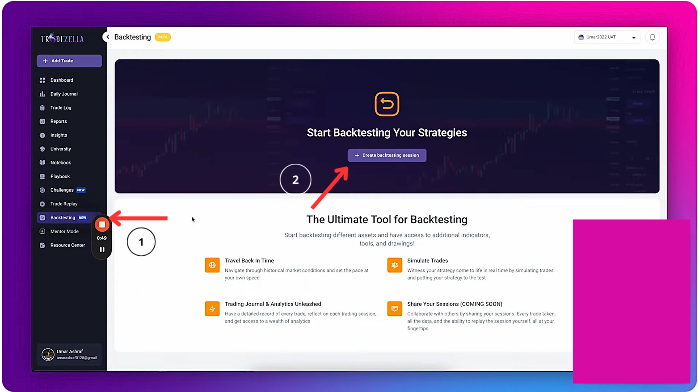
From here, we created a new backtesting session and named it “Opening Range Test“.
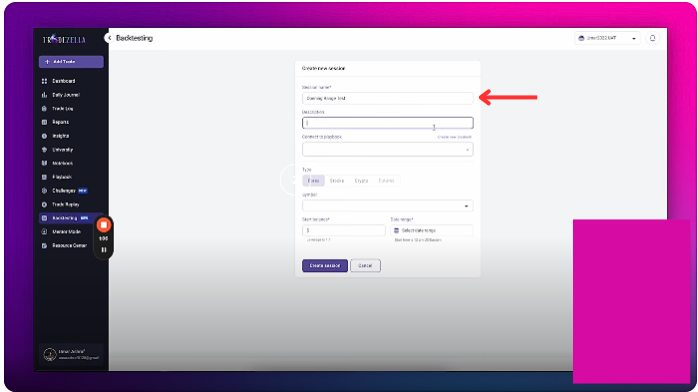
You can connect it to a Playbook (a strategy template), which is useful if you’ve already defined trading setups you want to test.
Pro Tip: If you don’t have a Playbook yet, TradeZella lets you create one directly from this screen.
Step 2: Setting Up Market Conditions
Before starting, you need to define:
- Asset Class: Stocks, Forex, Crypto, Indices
- Instrument: We chose US30
- Starting Balance: $100,000
- Date Range: December 5 – January 25
Once set, we clicked Create Session, and TradeZella loaded the historical market data.
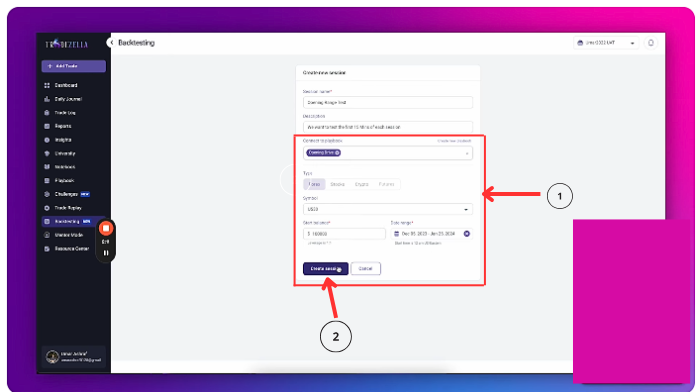
Step 3: Placing and Managing Trades
Once inside the session, TradeZella behaves exactly like a live trading platform—except you’re trading historical data.
Here’s what you can do:
- Place market & limit orders
- Adjust stop-loss & take-profit levels
- Modify risk per trade (1%, 2%, etc.)
- Fast-forward or rewind market data
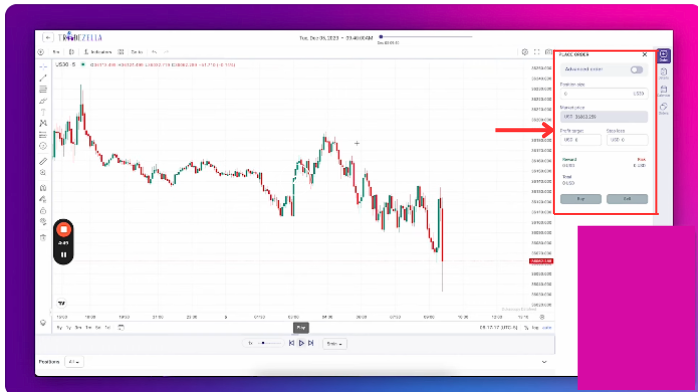
For example, we shorted US30 at resistance, set a 2% risk, and adjusted our stop-loss.
The tool calculated our position size automatically, showing how much we’d lose or gain based on the trade outcome.
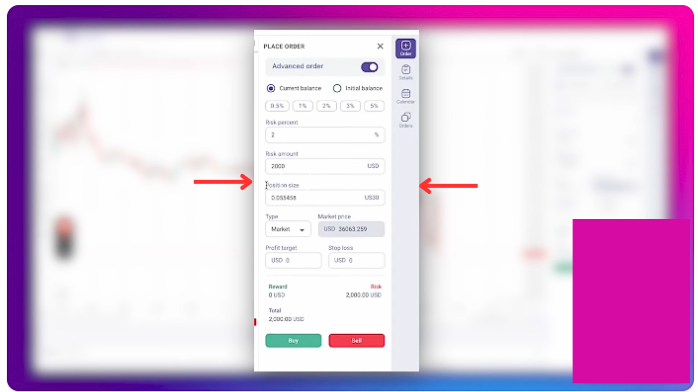
Pro Tip: You can drag & adjust stop-loss and take-profit levels directly on the chart, making trade management much easier.
Analyzing Performance: TradeZella’s Strength
One of the biggest advantages of TradeZella’s backtesting is the deep analytics.
After each trade, you can review:
- P&L per trade & per session
- Win rate & drawdown stats
- Equity curve visualization
- Replays of past trades
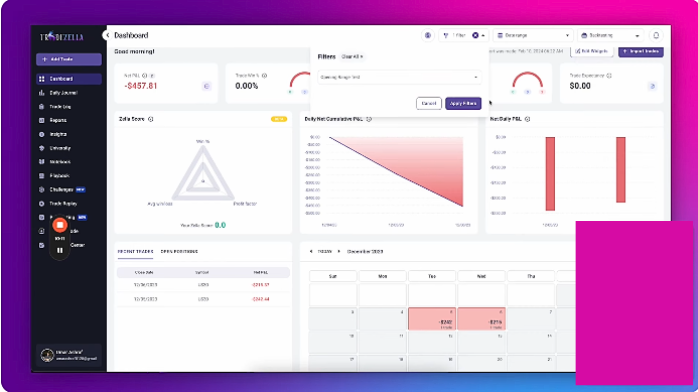
This helped us identify weaknesses in our strategy.
In our case, we had a 0% win rate on Day 1 but noticed our entries improved over time.
Pro Tip: You can tag trades & write notes to keep track of patterns you observe.
TradeZella Backtesting: Pros & Cons
✅ Pros:
- Realistic trade simulation (fast-forward, pause, replay)
- Comprehensive trade analytics (win rate, P&L, drawdown)
- Works with Forex, stocks, crypto, indices, and futures
- User-friendly with drag & adjust stop-loss/take-profit
- Seamless Playbook integration for strategy testing
❌ Cons:
- No free version – requires a subscription
- Lacks built-in strategy automation (you place trades manually)
- Limited indicators compared to TradingView
How Does It Compare to Other Backtesting Tools?
TradeZella vs. TradingView Replay Mode
| Feature | TradeZella | TradingView |
|---|---|---|
| Multi-asset support | ✅ Yes | ✅ Yes |
| Deep analytics | ✅ Yes | ❌ No |
| Strategy Playbooks | ✅ Yes | ❌ No |
| Fast-forward/Rewind | ✅ Yes | ✅ Yes |
| Subscription Required | ✅ Yes | ✅ Yes |
TradeZella vs. Forex Tester
| Feature | TradeZella | Forex Tester |
|---|---|---|
| Multi-asset support | ✅ Yes | ❌ Forex only |
| Strategy automation | ❌ No | ✅ Yes |
| Built-in indicators | ❌ Limited | ✅ Extensive |
| Subscription Required | ✅ Yes | ❌ One-time fee |
If you’re primarily a Forex trader, Forex Tester might be a better option since it allows automated backtesting.
However, for multi-asset traders who want deep analytics, TradeZella is superior.
Is TradeZella Backtesting Worth It?
Who Should Use It?
- Beginner traders who want to test strategies risk-free
- Advanced traders looking for deep analytics on past performance
- Traders using stocks, Forex, and crypto on one platform
Who Shouldn’t Use It?
- Traders looking for free backtesting options (no free plan)
- Automated strategy testers (it’s manual-only)
Final Verdict: Our Experience with TradeZella
After extensively testing TradeZella’s backtesting feature, we think it’s one of the best tools for manual strategy testing.
- Extremely realistic trade simulation
- Detailed performance analytics
- Great for Forex, stocks, crypto traders, and futures
However, it’s not for everyone.
If you’re looking for automated strategy backtesting, you may want to consider alternatives like Forex Tester or TradingView’s Pine Script.
Overall Rating: 8.5/10
Would we recommend it? Yes, if you’re serious about refining your trading edge.


